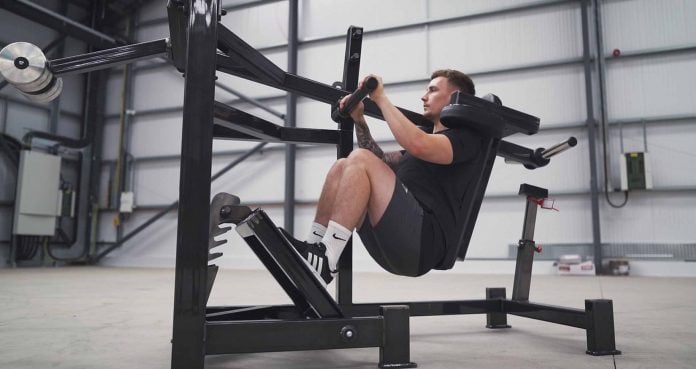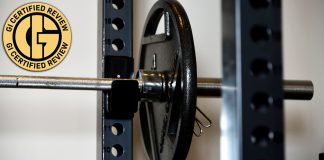
The shark pit squat effectively engages the lower body muscles without placing excessive load on the spine.
The squat is a highly functional exercise that effectively targets your lower body muscles. However, it’s essential to consider the potential strain it can place on your spine. That’s why athletes have developed variations like the belt squat and goblet squat, which minimize the stress on your back while still providing the desired benefits (1).
The shark pit squat is an excellent alternative to the belt squat for leg targeting. This variation, performed on the pit shark machine, provides a more excellent range of motion. If the belt squat machine is unavailable at your gym, don’t worry! Load up the pit shark machine and effectively engage your muscles.
Shark pit squats offer a unique chance to target and strengthen your lower body. However, it’s crucial to execute this exercise with proper form. This comprehensive exercise guide demonstrates the correct technique for shark pit squats and highlights the advantages of incorporating this routine into your fitness regimen. Additionally, it introduces three other squat variations that effectively enhance lower body strength and size.
Techniques & Muscles Worked
The shark pit squat works on similar muscles to the back squat. However, like the belt squat, it targets your quads, glutes, hamstrings, and calves differently (2). The shark pit squat is also more quad-focused because loading happens at the hips.
The shark pit squat is a great way to build your leg muscles. This exercise can zero in on your posterior chain or quad muscles, depending on your stance. Below is a step-by-step guide to this routine.
- Put the pit shark machine belt around your waist and adjust it to be low on your hips.
- Attach the hook from the belt directly underneath you, then stand up to set your stance. This is your starting position.
- Hold the machine handles and squat by flexing your hips and knees simultaneously.
- Descend till your thighs are parallel to the ground, and then pause.
- Drive through your whole foot and rise to return to the starting position to complete the rep.
- Repeat for as many reps as you desire.
Benefits
The shark pit squat is a safer alternative to other squatting variations. Performing this exercise allows for a more profound squat, which results in increased muscular engagement due to extended periods of tension. This study on time under tension shows that it’s a critical factor for muscle hypertrophy (3). Here are other benefits of this exercise.
Grow Bigger Legs
While the back squat does work on your legs as a whole, the positioning of the shark pit squat belt puts the load more effectively on your legs. Over time, this will result in muscle growth and increases in strength.
Less Strain on the Lower Body
During regular back squats, the barbell puts the load on your spine. You also require some level of shoulder mobility to carry the barbell. These are all removed from the equation when you do the shark pit squat, as the load is on your hips.
More Back Friendly
The shark pit squat doesn’t create tension in your lower back as much as the regular back squat. So, those with lower back pain or injuries can use this routine to train their lower body.
Safer
Since the shark pit squat doesn’t put as much load on your spine or trunk muscles, it’s a safer squat variation to engage the muscles in your lower body. The pit shark machine also has built-in safety spotters to help you stop if your body gives out.
Carryover to Squats & Deadlifts
Shark pit squats give you a greater sense of driving the weight through your hips. Over time, this movement pattern will lock in, which is helpful as it is the correct pattern for a successful squat. You can then use this to improve the form of your regular squats and deadlifts.
Shark Pit Squat Alternatives
The shark pit squat is a belt squat variation that will be useful if included in your workouts. You can also try out the following squat variations.
Goblet Squat
Goblet squats also work on your hamstrings, quads, glutes, adductors, and calves. You can use a kettlebell or dumbbell for goblet squats, but you hold the weight in front. This makes them more back-friendly as the load acts as a counterweight.
Landmine Belt Squat
You can do belt squats like the shark pit if a landmine is available. This routine is also back-friendly and will load your lower body effectively.
Cable Hip Belt Squat
The cable hip belt squat also works your muscles like the other belt squat variation. The only difference is that you link the belt to the lowest setting on the cable machine and then take some steps back.
FAQs
What are pit shark squats?
Pit shark squats are a variation of belt squats on the pit shark machine. This allows you to do a deeper squat and puts your lower body muscles under tension for longer.
How do you use a shark pit exercise machine?
You stand on the pit shark machine for a belt squat and connect the belt directly under you. Then, stand up and do squats normally.
How do you target the glutes with the pit shark squats?
To target glutes on the pit shark machine, use a wider stance. This hits the posterior chain muscles, including your glutes, better. Using a narrow stance makes it more quad-dominant.
Follow us on Instagram, Facebook, and Twitter for more exercise guides!
References
- Joseph, L., Reilly, J., Sweezey, K., Waugh, R., Carlson, L. A., & Lawrence, M. A. (2020). Activity of Trunk and Lower Extremity Musculature: Comparison Between Parallel Back Squats and Belt Squats. Journal of human kinetics, 72, 223–228. https://doi.org/10.2478/hukin-2019-0126
- Evans, T. W., McLester, C. N., Howard, J. S., McLester, J. R., & Calloway, J. P. (2019). Comparison of Muscle Activation Between Back Squats and Belt Squats. Journal of strength and conditioning research, 33 Suppl 1, S52–S59. https://doi.org/10.1519/JSC.0000000000002052
- Mang, Z. A., Ducharme, J. B., Mermier, C., Kravitz, L., de Castro Magalhaes, F., & Amorim, F. (2022). Aerobic Adaptations to Resistance Training: The Role of Time under Tension. International journal of sports medicine, 43(10), 829–839. https://doi.org/10.1055/a-1664-8701















